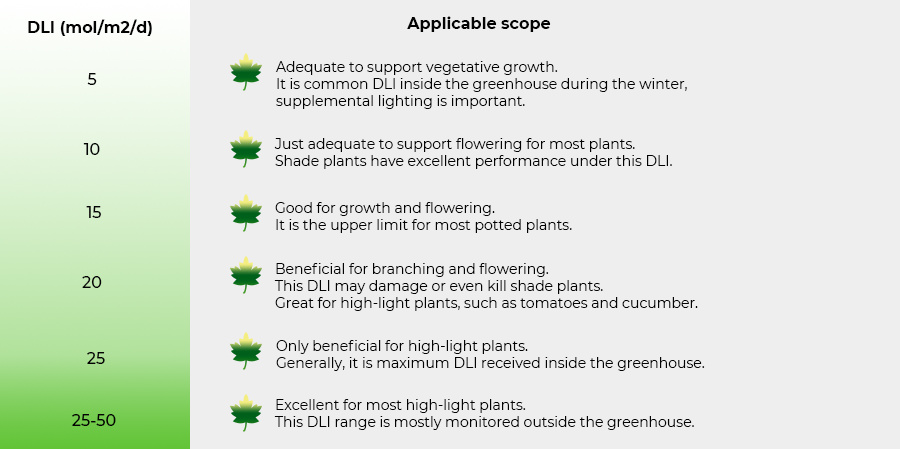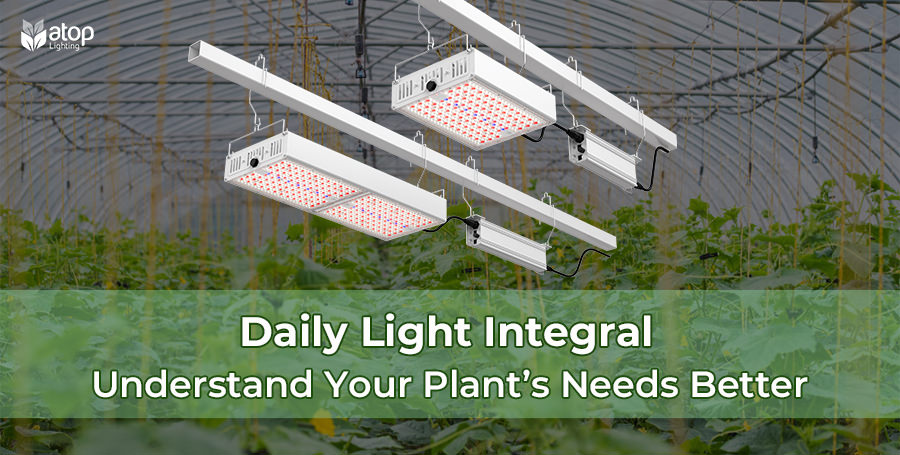DLI (Daily Light Integral) - Understand Your Plant’s Needs Better
Light is one of the most important energy sources for plants. Adequate amount and duration of light benefits photosynthesis and promotes plant growth. In summer, it is not a serious problem; but for autumn and winter days, light is generally inadequate for plants to thrive. Modern greenhouses utilize artificial grow lights to supplement light for plants. To figure out the optimal light that plants need, a number of measurements are used to calculate the light quantity, light level, and light intensity. Growers are familiar with the terms ‘PAR’, ‘PPF’, and ‘PPFD’. Nowadays, most growers also be cognizant of the term ‘daily light integral (DLI)’, which is the total amount of light in the PAR range that a plant received per day. Plant growth is associated with DLI in the greenhouse. A better understanding of DLI helps grower understand plants’ need more accurately and provide supplemental light for plants more precisely. This post is divided to 4 parts. The first part will introduce the concept of DLI. It will then show you the effects of DLI on greenhouse horticulture, followed by methods for calculating greenhouse DLI. Lastly, it will tell you how much DLI do your plants need.
What is DLI
DLI is the acronym of Daily Light Integral. It measures the sum of photosynthetic light (light in PAR range which is beneficial for photosynthesis) plants received over an entire day (a 24-hour period). The unit of DLI is ‘mol/m²/day’. In other words, it reported the PAR photons that intercepted by plants surface in 24 hours. PPFD (Photosynthetic Photon Flux Density) is known as the amount of photosynthetic active photons that fall on a given surface per second. It stands for the lighting efficacy of artificial grow light. However, not only the light intensity but also the duration is critical for plant growth. PPFD takes light efficacy into account but ignores the important the light duration. Thus, DLI is more effective in calculating the supplemental light for plants than PPFD. Since the lighting control in indoor growing is easier to control than a greenhouse, DLI is a simple metric for indoor growing. But it is more difficult to calculate under greenhouse cultivation because of the varied climate conditions and seasonal changes. Light levels in a greenhouse are varied.
How does DLI affect greenhouse horticulture
As mentioned above, DLI is the sum of photosynthetic light plants received in 24 hours. Thus, DLI has significant effects on plant growth and development. Insufficient DLI limits plant growth and development. DLI less than 10 mol/m²/d is regarded as the limited lighting condition for many plant species. Growers should take actions to increase DLI in a greenhouse. In general, increasing DLI is beneficial to roots, leaves, branching, flowers, and fruits, and then improve plant quality and yields. But the positive effects are only appeared in the amount of appropriate limits DLI. For most floriculture plants, increasing DLI brings more roots, more branches, thicker stems, larger flowers, and shorter time for flowering and fruiting. For low light plants like foliage plants, however, higher DLI is unbearable. In contrast, fruiting vegetables such as cucumber and tomato are capable of tolerating high light conditions. The size and quantity of fruits will be increased with DLI. Growers monitor the DLI in a greenhouse and then compare the values to a plant’s needs. From this process, growers can figure out whether they should supplement light or shade the plants. In the long term, providing appropriate DLI contributes to better plant growth, as well as reducing unnecessary energy consumption.
How to calculate greenhouse DLI
Calculating DLI is complex and time-consuming. Both light intensity and duration are involved in DLI calculation. But light intensity and duration are variable. They are all constantly changing as the seasons go by. Furthermore, light intensity in a greenhouse is instantaneous. Except for natural impacts, construction of a greenhouse, locations for collecting data, and other factors will also affect the DLI values. Therefore, measurements of DLI should be repeated and averaged.
-
Methods to calculate greenhouse DLI
Light sensors are widely used to measure light intensity. Sensors are connected to a computer, and then the values will be recorded automatically. Since most light sensors utilize photometric unit, µmol/m²/d, the values can be converted into DLI value in mol/m2/d easier. If not, we have to convert the values from µmol/m²/s to mol/m²/d. Firstly, calculate the average light intensity over a 24-hour period (from midnight to midnight) in µmol/m²/s. Secondly, convert the light intensity over 24-hour period in µmol/m²/d. At last, derive the DLI in for that day in mol/m²/d. Equation for calculating DLI is as followed:
DLI = ((Average light intensity over a 24-hour period)*(3600*24)) / 1,000,000
3600: number of seconds in one hour.
24: number of hours in a day.
1,000,000: the number of µmol in 1 mol.
-
Factors influence DLI measurements
-
Position of sensors
Though light sensors are convenient to record to light intensity, positions of them can affect the values significantly. Light sensors should be placed inside the greenhouse rather than outsides. The DLI measured outdoor is higher than indoor one. Moreover, DLI measured in higher places like truss are higher than the DLI measured on floor. The right position of the light sensors should be the places where plants are growing.
-
Natural factors
As the season rolls on, DLI is varied. Of course, the DLI in the winter is lower than summer without supplemental lighting. Weather condition is also an important factor to DLI. Shadows cat in sunny day is darker than cloudy day’s. Light intensity measured in the shadow of greenhouse will increase if the clouds move away.
-
Light transmission
Different materials and constructions of greenhouse have influences on light transmission. Glazing material enables up to 90% light transmission while highly diffused glass allows only 35% to 70%. It means that light is compromising when it filters through the roof of greenhouse. For example, if we use high diffused glass greenhouse and the outdoor DLI is 20 in the winter, the DLI inside the greenhouse ranges can be as low as 7. Obviously it is inadequate for most plants.
How much DLI do your plants need
The range of average DLI for plants is 3 to 20 mol/m²/d. But the amount of DLI required by plants is differentiated from species and growing stages. The common greenhouse crops such as tomatoes can bear the DLI about 40 mol/m²/d. Cannabis is special, and it can be tolerant of the DLI up to 50 mol/m²/d or more. Here is a table about the DLI for different plants and conditions.

In fact, the maximum DLI plants received in a greenhouse is about 30 mol/m²/d. But the DLI can drop to 2 mol/m²/d in winter or cloudy day. Therefore, supplemental lighting is important for greenhouse horticulture. Unlike traditional HPS grow lights, LED grow lights are cost-effective and energy-saving. LED grow lights can provide higher DLI and custom light spectrum to achieve optimal growth and development. Regardless of replacing HPS grow lights or selecting new grow lights, Horti-Top can add values. Horti-Top is an outstanding fixture with only 8.5 kg net weight, which is ideal for greenhouse installations. It can be compatible with existing layouts and replace the HPS light seamlessly. Interested in Horti-Top? Contact us and find more information.



